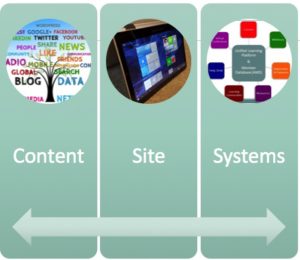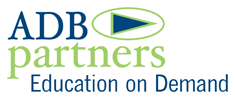This post first appeared in the iCohere Academy
Our fourth session of Unified Learning Design Studio covered the most important resource — people. There are duties that must be filled by staff and there are duties best filled by external experts (contractors, vendors, consultants). We explored various roles and responsibilities. Tips were shared for maximizing the staff-member connections and the special expertise of external partners
Session four recap:
Our most important resource when developing an eLearning program is people. These individuals make up the team which is instrumental in creating a successful Unified Learning Program.

image by geralt
Who is on your eLearning team?
Why does your eLearning team matter? There are two reasons this discussion is vitally important.
- Best use of our resources. When we delineate roles and responsibilities and even recreate the structure of those relationships, we can make the best use of our talent. Understanding and building dynamic teams can help with wise resource management.
- Quality of learner experiences. Of course, the most important reason that your eLearning team matters is the quality of learner experiences! The design, development, maintenance, and service may all seem to be background, but they must work as a well-oiled machine – basically transparent in nature. The learner experience should be seamless, easy, and effective – so the busy adult professional can laser-focus on the task at hand – continuing education.
As we explore the important roles and responsibilities of the eLearning team, we focus on three key questions to guide us through the process of building our team for unified learning success.
- What are three non-negotiable roles and responsibilities in quality unified learning?
- How do you connect silos for eLearning success?
- What people formulas make for the most successful eLearning?
Three Non-Negotiable Roles in Unified Learning
#1 CONTENT
Content is the bedrock of eLearning. With our era’s dependency on the Internet, we are swimming in content. Access to so much content makes it important to have someone whose focus is to distill all that content into meaningful ways to learn and apply based on our eLearning goals. Two key roles responsible for content are the editor and curator.
- EDITOR OR EDITORIAL FUNCTION: The editor, or person who handles editorial duties, connects the content of the curriculum, eLearning authors, instructional designers, and most importantly learners. This key role keeps the goals of learners and curriculum aligned.
- CURATOR: The curator can be the editor, however this role is focused on four functions around collecting critical pieces and items for content. The functions are inspiration where we use the sources we collect to spark interest, second is instruction and how we reuse assets to create a new learning experience, integration which is blending our meanings to create a new understanding of all that we have collected, and finally, implementation which is putting together materials for implementation; for elaboration, see the article by Ben Betts and Allison Anderson in TD January 2016 (https://www.td.org/Publications/Magazines/TD/TD-Archive/2016/01/Diamond-in-the-Rough). Responsibilities of the curator include:
- Locating materials
- Selecting and assessing materials against learner goals and curriculum goals
- Analyzing materials
- Organizing and publishing the content
#2 SITE ADMINISTRATION
The difference between a site that drives, encourages and nurtures learning and a site that is simply a completed template is the site administrator.
- SITE ADMINISTRATOR: Look for someone who can be a gatekeeper but someone who has a vision and a clear understanding of the system you are using and learner goals. This role will analyze, set up a process, seek solutions and really build success into a unified learning environment. The right site is a rich learner eco system and the site administrator is the person who embraces and understands the system using all of the different options available.
- LEARNERS AS SITE ADVISORS: When developing the learning eco system, the site administrator will work with many teams, the most important of which is a team of learners who will actually be using the system. By working with learners as we develop the learning site, we ensure that our focus is on what is most valuable to the learners.
#3 SYSTEM INTEGRITY
When we think about the team and the different responsibilities, system integrity frequently falls into the hands of our system vendor. We must have a setting and a system that are rock solid with no doubt that it is going to operate. We need a partner that will resolve our issues and keep the system running smoothly. When partnering with a vendor, focus on finding a system known for scalability, reliability and security, e.g., iCohere.
How Do You Connect Silos for Quality eLearning?
When developing a unified learning system, there is a relationship between the content we are developing, the site hosting the eLearning program, and the system that brings it all together. These key components are designed to work together, but could very well work entirely on their own in silos. For successful unified learning, we must ensure we don’t work in silos because each is so dependent on the work of the others.
To connect silos for quality eLearning, remember these tips:
- Tap the best people to handle these responsibilities –— content, site administration, and system integrity. These talented individuals may be staff and they may be external partners. Identify these key players before the eLearning work begins.
- Engage the people responsible for content, site administration, and system integrity throughout the process. Even if the topic at hand does not appear to be in someone’s wheelhouse, engage them anyway. Different perspectives and collective understanding strengthens silo connections.
- Keep the cross-silo communications active through thick and thin. There will be challenges in the design and development of unified learning. Everyone needs to understand the challenges, help with solutions, and celebrate the successes.
What People Formulas Make for the Most Successful eLearning?
In the Unified Learning Design Studio, we provided a template to guide us when creating the structure of the eLearning team. The tool reviews the non-negotiable roles and who should take on these roles, and we also look at the learner experience and all of the functions that make up the experience. The template guides us to look closely at the communication between the organization and the learners, by identifying channels most meaningful to the users. Channels may be direct outreach, social media, membership marketing or another form of communication.
In our next session of Unified Learning Design Studio, we look at Making the Business Case for eLearning and what business models are most effective. Too often, eLearning is an add-on — literally. It’s like organizations jump on the eLearning bandwagon without really thinking about the business implications. We will look at how to create a one-page business case that can become a unified learning lodestar.
Mark your calendars for June 14, our next Unified Learning Design Studio webinar:
Making a Business Case for eLearning – Business Models that Work
If you have not registered yet, you may do so anytime, attend any or all sessions, and gain access to all webinars and materials in the series.
Recordings are made available after each live session.
This post was written in collaboration with Jo Lynn Deal, myMarketing Cafe.
Unified Learning Design Studio is a free 10-part webinar series presented by Dr. Amanda Batson, ADB Partners, LLC, and Lance Simon, EVP, iCohere.
Select images by geralt.

